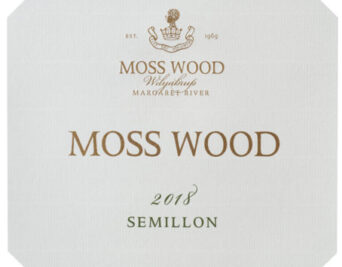Moss Wood 2018 Semillon

| Wine Facts | |
|---|---|
| Median Harvest Date | 14th March, 2018 |
| Harvest Ripeness | 14.1°Be |
| Yield | 8.90 t/ha |
| Day Elapsed between Flowering and Harvest | 119 days |
| Bottled | 10th July, 2018 |
| Released | 8th November, 2018 |
| Alcohol | 14% |
Wine Facts
-
Median Harvest Date
14th March, 2018
-
Harvest Ripeness
14.1°Be
-
Yield
8.90 t/ha
-
Weather Data
Growing season Ave Temperature - 19.6⁰C
Number of hours accrued between 18° and 28⁰C – 1197
Number of hours above 33⁰C – 16
-
Days Elapsed between Flowering and Harvest
119 days
-
Bottled
10th July, 2018
-
Released
8th November, 2018
-
Alcohol
14 %
Vintage Notes
By virtue of its maritime climate, Margaret River has fairly consistent conditions from one year to the next. However, if we taste a range of vintages, it’s possible to see they are not exactly the same and we get small variations in style and fruit intensity. Generally speaking, we prefer warmer conditions because in that same lineup of vintages, it’s almost certain the hotter years will look the best. The easiest way to illustrate this is to taste each of the wines we made in the 2006 and 2007 years and we’d be London to a brick the latter would be preferred.
Looking at the white varieties, this is almost counter intuitive, because our region is not considered cold. Therefore, Chardonnay, Semillon and Sauvignon Blanc might be expected to show their brightest and most delicate characters in cooler years. Nevertheless, the fact is they all look a bit on the green side unless we’ve had a warmer summer. Our best guess is the general lack of extreme heat is the key and is one of the reasons why we log the temperatures above 33°C as a guide to likely fruit ripeness.
Considering all the above, readers won’t be surprised to learn that after our relatively cool and wet 2016/17 growing season, we were pleased to enjoy a more normal year in 2017/18. For an unirrigated vineyard like Moss Wood, we could hardly have asked for better. Rainfall of 1117mm was up for the year by 10%, providing plenty of soil moisture for the vines to cope with the yield of 8.90 tonnes/hectare. This was down slightly (12%) and probably the result of a day of rain and cool temperatures right at the end of flowering.
Glorious conditions were the order of the day during the period from flowering to harvest. In the end, the Semillon racked up 1140 hours between 18 and 28°C, well above our desired minimum of 1050, plenty of sunlight and warmth to keep them photosynthesizing and ripening the crop. There was very little in the way of extreme heat, with only 13 hours above 33°C and in the context mentioned above, we had to pick the fruit a little riper than average to get full flavour. In 2018 we picked at 14.1° Baume, notably higher than the average of 12.7°. The actual harvest date was only 4 days later than average on 14th March but this gave a total of 119 days from flowering to harvest, 11 days longer than normal, confirming the need for more time on the vine in cooler years.
The fruit was in terrific condition, with no disease or bird damage.
Production Notes
One of the defining and beautiful parts to making Semillon is the simplicity of technique. After picking by hand, the bunches were sorted for unwanted contaminants like leaves and stems and then put straight into the presses. The pressed juice was sent to stainless steel tanks, where it was settled for 48 hours and 10°C. Clear juice was racked to a second stainless steel tank where fermentation was carried out by multiple yeast strains and controlled to a temperature of 18°C. After fermentation was completed, the wine was immediately prepared for bottling and was fined with bentonite, for protein stability but needed no other fining. It was then sterile filtered and bottled on 5th July, 2018.
Our intent is to maximise the retention of the young fruit aromas then get the wine quickly in to bottle to capture these and then allow the cellaring process to build the complexity.
Tasting Notes
Colour and condition:
There is a medium to deep straw colour, with green tints and the wine is in bright condition.
Nose:
An absolutely classic Semillon combination of green apples and figs but with the added complexity of stewed pears and cinnamon. As always, there’s a touch of earthiness suggesting barrel aging but this is definitely not the case.
Palate:
In the mouth there is a rich mouthfeel, not always a feature in young Semillons. The fig and pear fruit flavours combine with full body to smooth out the acidity and tannins, so necessary for cellaring but this year sitting nicely in the background. The net result is good length and drinkability.
Cellaring
With all this delicious stuff going on, the 2018 Semillon will certainly tempt people to consume it now and frankly, it is indeed a very consumable youngster. However, we have our normal aging expectations and would recommend it be kept for at least a decade, to see the butter and toast complexity begin to emerge on the nose and to see some further softening of the palate. For those who enjoy classic, complex Semillon they will need to wait at least another decade after that to see the wine at full maturity
